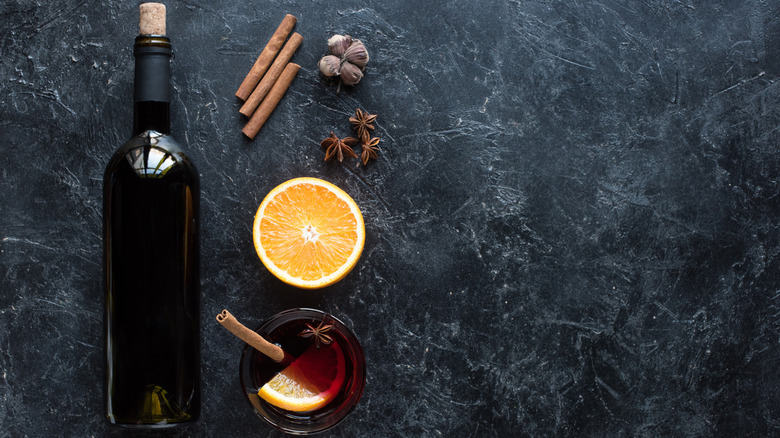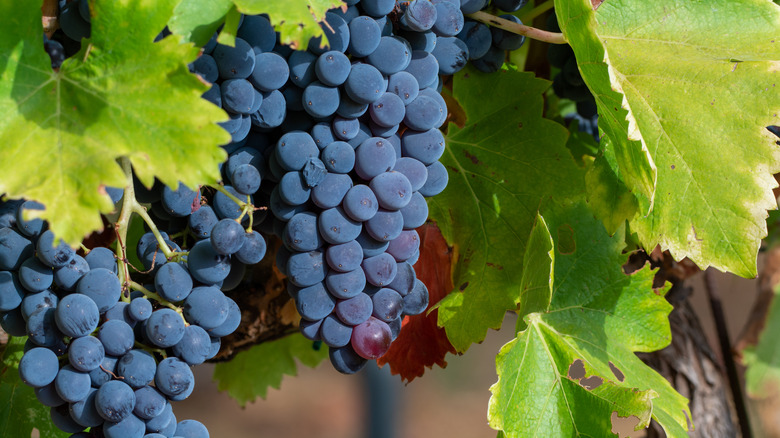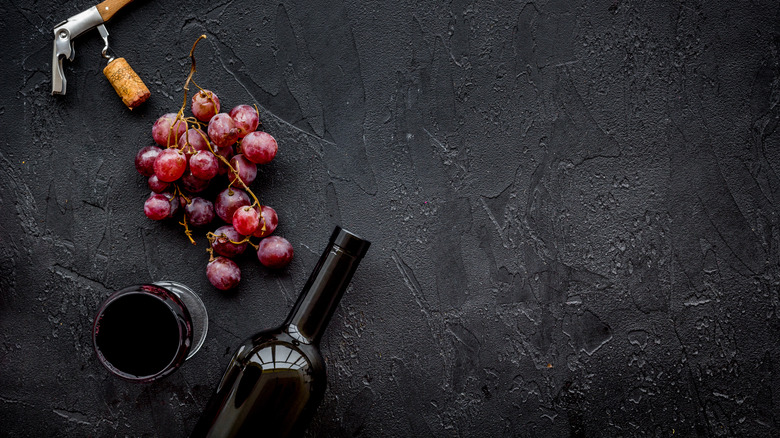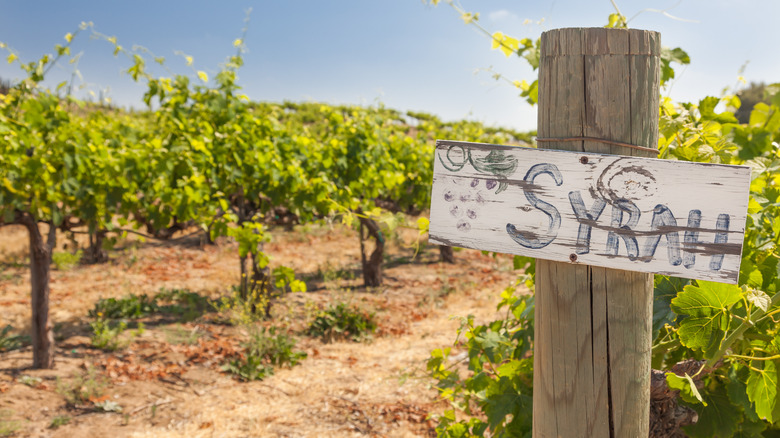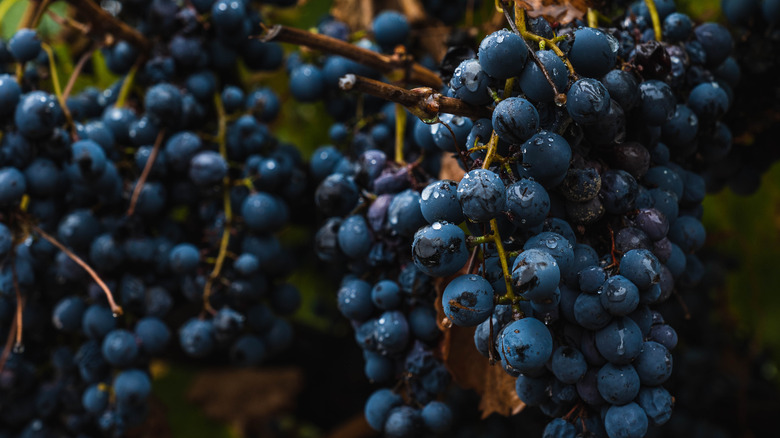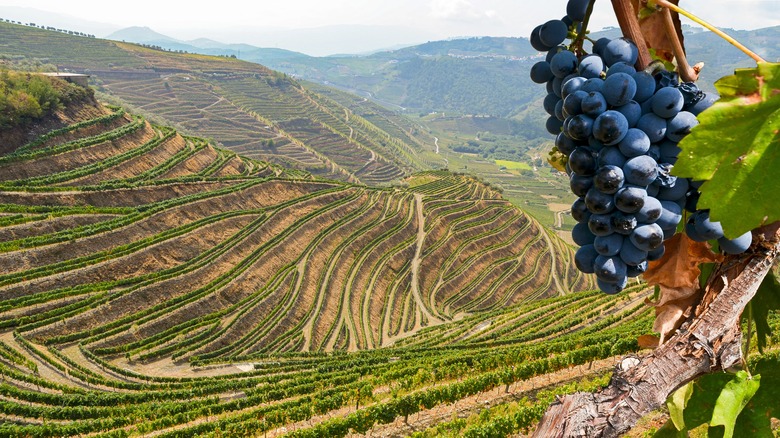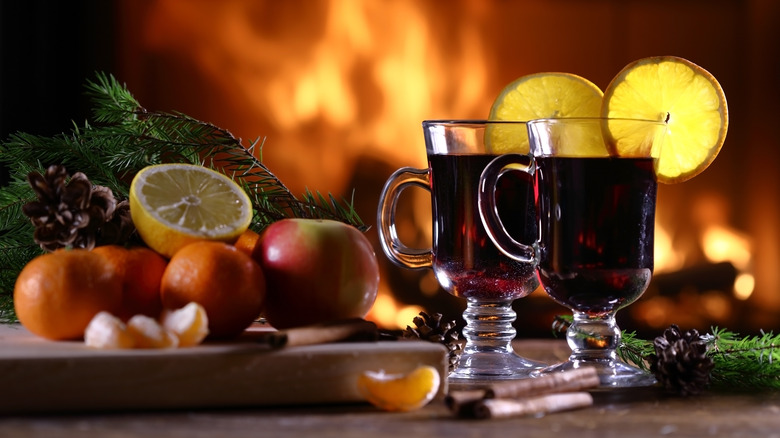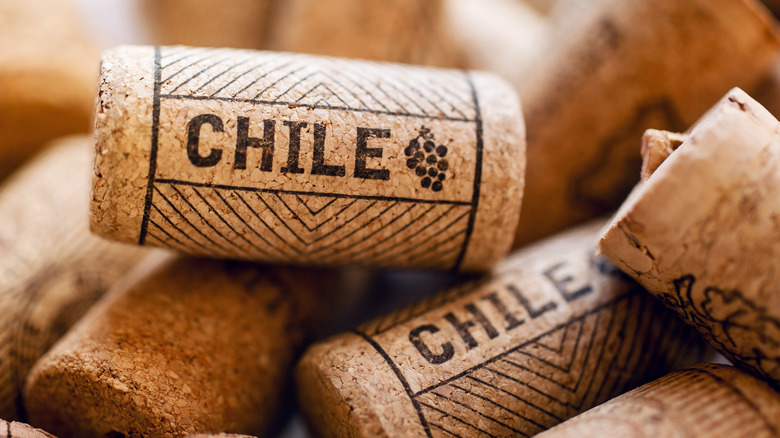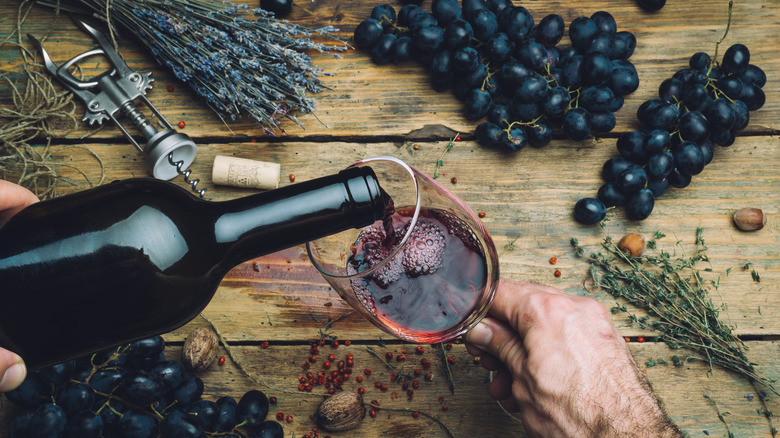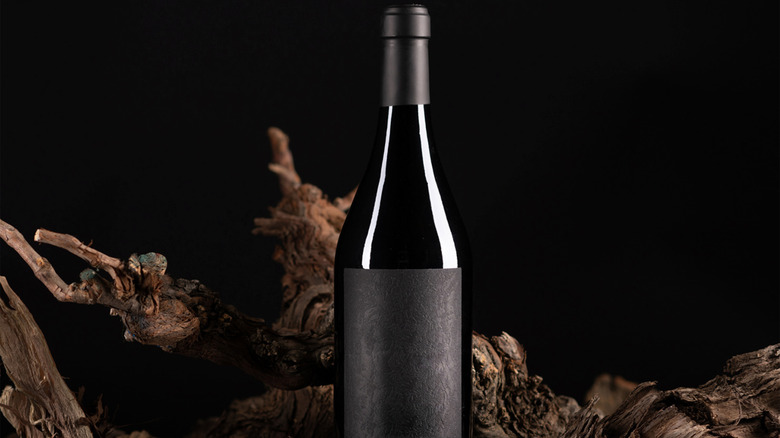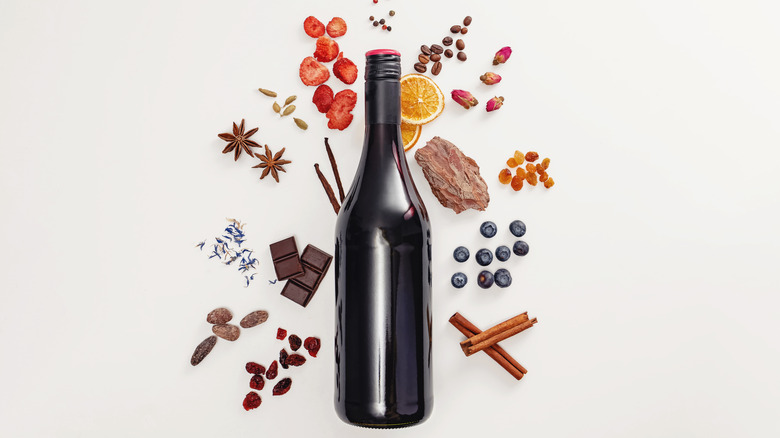The 13 Best Types Of Wines To Use For Mulled Wine
Mulled wine, glög, glühwein — whatever you call it, it's coziness in a mug. According to The Back Label, the beverage dates back to ancient Greece and gained popularity in the Middle Ages. However, most people recognize it as the warm and aromatic holiday beverage served in Germany, Austria, and Scandinavian countries. A sip will transport you to a European holiday market, surrounded by twinkling lights and joyful music. In fact, according to German Wine USA, glühwein translates to "glow wine."
To get your glow on is simple and can be done on a stovetop or in a slow cooker. There are only a few ingredients — red wine, orange juice, and zest, plus spices such as cinnamon, clove, and star anise. Add brandy for an extra kick, honey for sweetness, or apple cider for a touch of acidity. Of course, it wouldn't be called mulled wine without the wine, but not all styles will mesh with your ingredients.
When choosing the wine there are a few factors to consider. The price should not break the bank — while it's the main ingredient, other strong flavors will be layered on top of it so stick with an affordable bottle of wine. The body should be medium — not so light that it is dominated by the spices and not so heavy that it masks the other ingredients. A tannic and parching wine might overpower the balance, as could a heavily-oaked wine. With that in mind, let's examine which varietals are best suited for making mulled wine.
Grenache (Garnacha)
Grenache, also known as Garnacha in Spain and Cannonou in Sardinia, has the perfect balance of jammy fruit flavors, a medium-to-full body, and the typical style is light on oak. This grape offers fresh raspberry, dark berry, and plum notes that will give richness to your mulled wine. Depending on where is it grown, it can display hints of spiciness that will work in your favor. Old World regions like Côtes du Rhône and Sardinia might offer more rustic iterations, while the jammier versions of Grenache come from New World wine regions like Australia and the United States.
If it wasn't for one winery, the U.S. might not have any Grenache to call our own. In 1989, Tablas Creek Winery in California began sourcing Grenache cuttings from the Châteauneuf-du-Pape region of France. It can produce wine that ranges from easy and fruity to the deeply extracted wines made with grenache in the Priorat region of Spain.
Merlot
"Sideways" may have soured wine drinkers on Merlot, even well after the film's release in 2005 (via NPR), but it happens to be the perfect bottling to use in your mulled wine. This grape is known for its layer of baking spices underneath juicy fresh cherry flavors — both of which are symbiotic to your mulling spices. While it is a breeze to find cost-effective Merlot, it is also the main grape used to make some of the most expensive and cherished wines in the world. Of course, we are talking about Bordeaux.
According to Decanter, Bordeaux is broken up into two areas: the left bank of the Gironde Estuary which uses predominately Cabernet Sauvignon, and the right bank which uses mostly merlot to make up the blend. A bottle of Petrus, made on the right bank using mainly Merlot can fetch up to $5000! Of course, you'll want to keep that bottle far, far way from your mulled wine recipe.
Red Zinfandel (Primitivo)
Red Zinfandel, called Primitivo in Italy, is a silky and plush varietal busting with ripe red berry fruit (via VinYang). Its hefty body can stand up to the mulling spices and not get lost in the mix. Strawberry and cherry are common flavors one might find, which was why Zinfandel became such a popular sweet, rosé-esque beverage in the '80s (via MWM).
Unfortunately, when it went out of style, just the word "Zinfandel" put a bad taste in consumers' mouths. ZAP (Zinfandel Advocates & Producers), is an educational organization looking to change that. It advertises as being dedicated to zinfandel preservation, education, and appreciation. By hosting events and educational programs, ZAP is flipping the script on the previous perceptions of the grape. As a way of showing your support, considering grabbing a bottle of Red Zinfandel the next time you plan to prepare a batch of mulled wine.
Syrah (Shiraz)
Whether you call it Syrah or Shiraz (as they do in Australia), don't call it late to the mulled wine party. Famous for the intense wines made in the Rhône Valley in France, it is also responsible for putting Australia's wine scene on the map in some ways, according to wine goddess Jancis Robinson. Spicy and full-bodied, Syrah packs a powerhouse of broody blackberry and black plum notes. Often boasting savory notes of black olive, black pepper, and sanguine flavors, using it in your mulled beverage will certainly make a bold statement.
This dark-skinned grape will bring a visual wow factor to your glögg, adding stunning contrast to the bright orange zest against the inky liquid. As Wine-Searcher notes when explaining how ripe and extracted Syrah tends to be, the flavor profile is certainly not demure. For mulled wine that packs a punch, this is a good bet.
Malbec
Although Malbec originated in Cahors, France, it is known as the darling of the Argentine wine industry (via VinePair). There is no shortage of Malbec on the market, so it should not be a problem to snag a bottle or two for your mulled wine. (According to Meininger's Wine Business International, as of 2021, annual sales of Malbec across the globe is upwards of 134 million liters.) This rustic varietal had a massive boom in the early 2000s that is still going strong. Its modest price point makes it a popular choice without compromising on taste.
Typically, Malbec delivers flavors of smoke-tinged blackberry, dark cherries and cocoa. Texturally, it is velvety, with ample acidity and a medium-to-full body. An undercurrent of earthiness will add that certain je ne sais quoi to your mulled wine creation. As an added bonus, Malbec's dark purple hue also makes for an aesthetically stunning concoction.
Tempranillo
Tempranillo is a wonderful stablemate to the spices and citrus in a mulled wine. However, the style of winemaking will be a factor to consider. Most often produced in the Rioja and Ribera del Duero regions of Spain, Tempranillo is a grape that delivers moderate-to-high tannins, medium body, and medium acidity. It offers a leathery blackcurrant profile that will add intrigue to your mulled wine. The tricky thing here is that it can be aged in new oak, so the more time spent in barrel means more oak flavor is imparted. As Jancis Robinson notes, since the '90s, production has shifted away from a lengthy barrel aging, paving the way for the true, dynamic flavor of Tempranillo to shine.
When choosing your Tempranillo, look for the word "joven" which means young and unoaked. You should have no problem finding a bottle as it is the most planted grape in Spain (via Harpers) — just keep in mind that the label may not state the varietal and may only say "Rioja."
Cabernet Franc
We'll be "franc" with you, this won't be the easiest varietal to find, but it's worth the hunt. Light, but not too light, Cabernet Franc is full enough to not be overpowered by your mulled wine ingredients and its soft tannins make for a pleasant harmony. It will also impart notes of dried herbs and pepper underneath its juicy raspberry, cassis, and bramble flavors. Interestingly, DNA analysis proves that Cabernet Franc is one of two parent grapes to both Merlot and Cabernet Sauvignon.
Cabernet Franc has long stood in the shadow of its offspring, but the varietal has been getting more attention as of late. In an article for VinePair, Shana Clarke writes that the grape, while important to Bordeaux-blends and red wine made in the Loire Valley, has become a darling to the Napa Valley as well. Whether a bottle comes from France or California, it should be a great anchor for your mulled wine.
Sangiovese
A classic, a friend to all, Sangiovese is the star that makes some of the most treasured wines. Roman god Jupiter certainly must have liked it — "Sangiovese" translates to "The blood of Jove" (Jove meaning Jupiter), and is said to have gotten this name because Jupiter loved it so much that it flowed through his veins (via Table Tales). Brunello, Chianti, and Super Tuscans are just some of the wines made using Sangiovese. It is grown globally, but Italy remains the region with the highest production — the most abundant plantings are in the Mediterranean region of Tuscany.
This varietal makes a balanced bottling with intriguing flavors of tart cherry, dried roses, and strawberry that will blend effortlessly with your mulling ingredients. Some find a savory aspect, reminiscent of tomato leaves, or even tea leaves. It should be easy to find a bottling that is made with light oak aging that is done in neutral barrels.
Barbera
Another Northern Italian grape FTW! Barbera's naturally high acidity will add zip and freshness to your mulled wine. In fact, Barbera is widely considered a great pairing with pizza because its acidity cuts through the richness of the cheese gorgeously (via The Grape Grind). On the palate it boasts an abundance of crisp cherry and blackberries. A hint of incense might come through as well. Its body is moderate and its tannic structure is delicate, so it is an excellent choice for a balanced mulled wine.
Confusion might set in when faced with two different options: Barbera d'Asti and Barbera d'Alba (via The New York Times). Fear not, these are both produced with Barbera, the only difference is where they are made. If you're looking to add more acidity to your mulled wine, Barbera d'Asti should be your bottle of choice. However, if you want to pour a more full-bodied wine into the mix, then opt for Barbera d'Alba.
Carménère
Is someone smoking in here, or is it just the Carménère? Hailing from the Médoc region of Bordeaux and well-known for its Chilean iterations, this grape is lauded for its seductive smokiness — almost like paprika (via The Three Drinkers). If you think a hint of campfire will up your mulling game, this is the wine to seek out.
In addition to smokiness, this grape can produce an array of intense aromatics. Wine Folly pointed out how high levels of the aroma compound pyrazine in the grape results in interesting flavor notes that include green bell pepper, eucalyptus, and cocoa powder. Other things you might pick up on the nose or palate are raspberry and pomegranate. Its medium body is also conducive to a balanced mulled wine and its bright purple hue makes for an eye-catching beverage. If you haven't tried Carménère before, we recommend tasting a pour on its own to savor its smoky complexity.
Cabernet Sauvignon
Okay, so we said to avoid wines that are overly tannic or too hefty in body, but if you are looking for a mulled wine that is more expressive than a typical recipe, Cabernet Sauvignon could be the grape for you. Big and bold, is the name of the game when it comes to this popular varietal. Bursting with notes of black pepper, tobacco, cassis, and woody, dark berry notes, cabernet sauvignon is sure to stand out — cutting through the layers of spices added.
Full-bodied and rich in tannins, cabernet sauvignon is commonly dubbed a "steak wine" (via Into Wine). It has such a stronghold on the wine industry, with many producers having a cult-like following. It is grown globally and adapts well to many different types of growing conditions. It can even grow in the desert — several wineries in China are growing cabernet sauvignon in the Gobi Desert (via Decanter). It can be found in a wide range of price points, but for this project, look towards Chile and Australia for better pricing options.
Petite Sirah
There is nothing petite about Petite Sirah. This varietal is lush and full, exuding notes of blueberries, violets, cocoa, and dried herbs. It does have a bold tannic expression but the tannins are smooth and velvety and they mingle with its high acidity beautifully. Even the color is bold! The inky purple hue (due to the compactness of the grapes and the proportion of grape skin to flesh) makes for an impressive display.
While it is a different varietal, Syrah happens to be one of its parents. You may come across this grape called by its other name, Durif, named for Dr. Francois Durif who founded it in 1880 in the Rhône Valley region of France (via MasterClass). Unfortunately, this is a harder-to-find grape but if you can get your hands on it, it will be worth your while. Most plantings are found in California but many other regions are experimenting with it (via The New York Times).
Red blend
If you want to add some variety to your mulled wine, a red blend will do the trick. Blending grapes is how to incorporate the ideal parts of different varietals to produce a harmonious product. Do you want a touch of smokiness? Add a dash of Carménère. Craving an acidic lift? Throw in some Barbera. While nearly every winemaking region makes a red blend, some have strict rules regarding which grapes can be blended, and how much of each can be used.
As an example, in Bordeaux, there are only seven grapes that are allowed in a red blend: Cabernet Franc, Merlot, Malbec, Carménère, and Petit Verdot (via UC Davis). Together they comprise some of the most sought-after wines in the world. However, wines from Bordeaux can be pricey and intimidating if you don't know what to look for. Keep an eye out for a bottle that carries the label Appellation Bordeaux Controlee or Villages to hit the ideal price point. For more adventurous blends to add to your mulled wine, focus on options from California and Australia, where there are fewer restrictions and many interesting blends are made.
